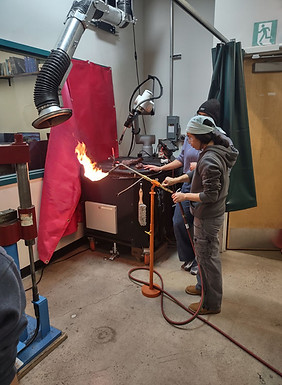Lessons Learned: Advice
The forged screwdriver was the most challenging project for me, specifically the grinding portion. The screwdriver tip had to be grinded down manually, it needed to be symmetrical, smooth, and have flat continuous faces on both sides. Because of this, when it comes down to grinding the screwdriver tip it is important to be very cautious about which grinder you choose. Some grinders in the EMEC remove material more aggressively than others, so if you're close to meeting tolerances, it's best to choose a grinder this less aggressive. A helpful tip is to wrap a piece of painter's tape around the shank to ensure you're hitting the same spot every time, it will make it easier to get a smooth consistent face.
For knurling, making sure the piece is squared properly and that both the knurling wheels engage at the same time so that the knurls are consistent. Be mindful of the brush hairs when you are applying oil during the knurling, they can get embedded in the piece if you don't remove them.
Project 2 | Forged Screwdriver
_edited_edited_edited.jpg)

Screwdriver Project Components and Processes

Cost Estimate
Considerations



Efficiency Improvement Proposal
A robotic grinding system shown to the right could grind the tip much faster than the manual grinding. Not only that, but the dimensions would be very precise.
Knurling manually requires a lot of manual processes like aligning the tool, adjusting the height, and being cautious of the knurling wheels and their contact with the blank. With a CNC Lathe we have advantages like the setup time, repeatability, and precision
Grinding
Knurling
Mass Production Cost: 10,000 units


The cost per unit goes from $200.88 from the manual EMEC production to $3.05 with automation!
